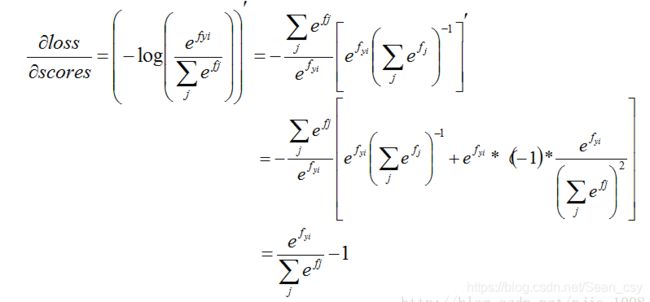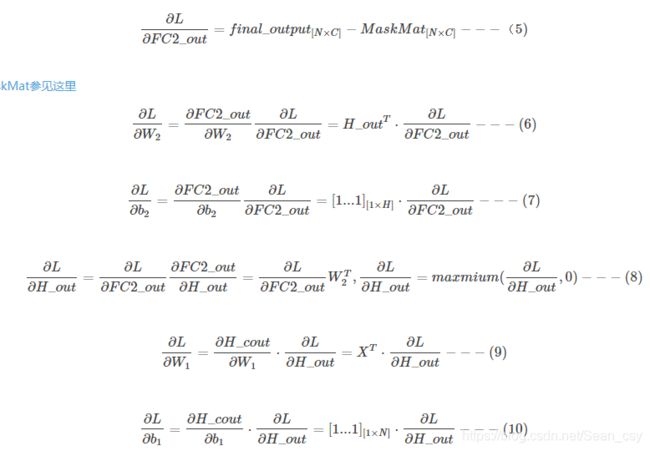cs231n assignment1_Q4_two_layer_net
A two-layer fully-connected neural network. The net has an input dimension of
N, a hidden layer dimension of H, and performs classification over C classes.
We train the network with a softmax loss function and L2 regularization on the
weight matrices. The network uses a ReLU nonlinearity after the first fully
connected layer.In other words, the network has the following architecture:
input - fully connected layer - ReLU - fully connected layer - softmax
The outputs of the second fully-connected layer are the scores for each class.
本次两层网络的作业难点还是在梯度的计算上,题目要求的两个激活函数分别是ReLu函数和softmax函数。来回顾一下。
对其求导
ReLu
softmax
这里求导要进行分类,当j!=yi 时:

当j==yi时:

在网络中,我们用反向传播算法来求梯度。以下公式来源(https://blog.csdn.net/yc461515457/article/details/51944683)
前向传播:
反向传播
在明确方法后,开始编写程序。
from __future__ import print_function
import numpy as np
import matplotlib.pyplot as plt
from past.builtins import xrange
class TwoLayerNet(object):
"""
A two-layer fully-connected neural network. The net has an input dimension of
N, a hidden layer dimension of H, and performs classification over C classes.
We train the network with a softmax loss function and L2 regularization on the
weight matrices. The network uses a ReLU nonlinearity after the first fully
connected layer.
In other words, the network has the following architecture:
input - fully connected layer - ReLU - fully connected layer - softmax
The outputs of the second fully-connected layer are the scores for each class.
"""
def __init__(self, input_size, hidden_size, output_size, std=1e-4):
"""
Initialize the model. Weights are initialized to small random values and
biases are initialized to zero. Weights and biases are stored in the
variable self.params, which is a dictionary with the following keys:
W1: First layer weights; has shape (D, H)
b1: First layer biases; has shape (H,)
W2: Second layer weights; has shape (H, C)
b2: Second layer biases; has shape (C,)
Inputs:
- input_size: The dimension D of the input data.
- hidden_size: The number of neurons H in the hidden layer.
- output_size: The number of classes C.
"""
self.params = {}
self.params['W1'] = std * np.random.randn(input_size, hidden_size)
self.params['b1'] = np.zeros(hidden_size)
self.params['W2'] = std * np.random.randn(hidden_size, output_size)
self.params['b2'] = np.zeros(output_size)
def loss(self, X, y=None, reg=0.0):
"""
输入层(D),全连接层-ReLu(H),softmax(C)
Compute the loss and gradients for a two layer fully connected neural
network.
Inputs:
- X: Input data of shape (N, D). Each X[i] is a training sample.
- y: Vector of training labels. y[i] is the label for X[i], and each y[i] is
an integer in the range 0 <= y[i] < C. This parameter is optional; if it
is not passed then we only return scores, and if it is passed then we
instead return the loss and gradients.
- reg: Regularization strength.
Returns:
If y is None, return a matrix scores of shape (N, C) where scores[i, c] is
the score for class c on input X[i].
If y is not None, instead return a tuple of:
- loss: Loss (data loss and regularization loss) for this batch of training
samples.
- grads: Dictionary mapping parameter names to gradients of those parameters
with respect to the loss function; has the same keys as self.params.
"""
# Unpack variables from the params dictionary
W1, b1 = self.params['W1'], self.params['b1']
W2, b2 = self.params['W2'], self.params['b2']
N, D = X.shape
# Compute the forward pass
scores = None
# fc1_out = X*W1+b1
# H_out = max(0,fc1_out)
# fc2_out = H_out*W2+b2
# final_output = softmax(fc2_out)
#############################################################################
# TODO: Perform the forward pass, computing the class scores for the input.
# 前向传播 #
# Store the result in the scores variable, which should be an array of #
# shape (N, C). #
#############################################################################
hidden_layer = np.maximum(0, np.dot(X, W1) + b1) # ReLU activation
scores = np.dot(hidden_layer, W2) + b2
print(scores.shape)
#############################################################################
# END OF YOUR CODE #
#############################################################################
# If the targets are not given then jump out, we're done
if y is None:
return scores
# Compute the loss
loss = None
#############################################################################
# TODO: Finish the forward pass, and compute the loss. This should include #
# both the data loss and L2 regularization for W1 and W2. Store the result #
# in the variable loss, which should be a scalar. Use the Softmax #
# classifier loss. #
#############################################################################
# softmax 损失函数公式
scores = scores - np.max(scores, axis=1, keepdims=True) #防止指数爆炸
exp_sum = np.sum(np.exp(scores), axis=1, keepdims=True)
#loss = -np.sum(scores[range(N), y]) + np.sum(np.log(exp_sum))
loss = np.sum(-scores[range(N),y] + np.sum(np.log(exp_sum)))
loss = loss / N + 0.5 * reg * (np.sum(W1 * W1) + np.sum(W2 * W2))
#############################################################################
# END OF YOUR CODE #
#############################################################################
# Backward pass: compute gradients
grads = {} #字典
#############################################################################
# TODO: Compute the backward pass, computing the derivatives of the weights #
# and biases. Store the results in the grads dictionary. For example, #
# grads['W1'] should store the gradient on W1, and be a matrix of same size #
#############################################################################
#计算score梯度 根据softmax求梯度公式。
#这部分需要重点理解
prob = np.exp(scores) / exp_sum #求导结果的一项,e^yi/Σe^j
prob[range(N), y] -= 1 #yi=j时候,求导的结果有个-1项
dscores= prob / N #这里注意和softmax里的区分
#反向传播求梯度
dW2 = np.dot(hidden_layer.T,dscores)
db2 = np.sum(dscores, axis=0, keepdims=False)
dhidden = np.dot(dscores,W2.T)
dhidden[hidden_layer <= 0] = 0 #max(0, ) 0求导还是0
dW1 = np.dot(X.T,dhidden)
db1 = np.sum(dhidden, axis=0, keepdims=False)
#正则化
dW2 += reg*W2
dW1 += reg*W1
grads['W1'] = dW1
grads['W2'] = dW2
grads['b2'] = db2
grads['b1'] = db1
#############################################################################
# END OF YOUR CODE #
#############################################################################
return loss, grads
def train(self, X, y, X_val, y_val,
learning_rate=1e-3, learning_rate_decay=0.95,
reg=5e-6, num_iters=100,
batch_size=200, verbose=False):
"""
Train this neural network using stochastic gradient descent.
Inputs:
- X: A numpy array of shape (N, D) giving training data.
- y: A numpy array f shape (N,) giving training labels; y[i] = c means that
X[i] has label c, where 0 <= c < C.
- X_val: A numpy array of shape (N_val, D) giving validation data.
- y_val: A numpy array of shape (N_val,) giving validation labels.
- learning_rate: Scalar giving learning rate for optimization.
- learning_rate_decay: Scalar giving factor used to decay the learning rate
after each epoch.
- reg: Scalar giving regularization strength.
- num_iters: Number of steps to take when optimizing.
- batch_size: Number of training examples to use per step.
- verbose: boolean; if true print progress during optimization.
"""
num_train = X.shape[0]
iterations_per_epoch = max(num_train / batch_size, 1)
# Use SGD to optimize the parameters in self.model
loss_history = []
train_acc_history = []
val_acc_history = []
for it in xrange(num_iters):
X_batch = None
y_batch = None
#########################################################################
# TODO: Create a random minibatch of training data and labels, storing #
# them in X_batch and y_batch respectively. #
#########################################################################
#随机取
sample_index = np.random.choice(num_train, batch_size, replace=True)
X_batch = X[sample_index]
y_batch = y[sample_index]
#########################################################################
# END OF YOUR CODE #
#########################################################################
# Compute loss and gradients using the current minibatch
loss, grads = self.loss(X_batch, y=y_batch, reg=reg)
loss_history.append(loss)
#########################################################################
# TODO: Use the gradients in the grads dictionary to update the #
# parameters of the network (stored in the dictionary self.params) #
# using stochastic gradient descent. You'll need to use the gradients #
# stored in the grads dictionary defined above. #
#########################################################################
dW1 = grads['W1']
dW2 = grads['W2']
db1 = grads['b1']
db2 = grads['b2']
self.params['W1'] -= learning_rate * dW1
self.params['W2'] -= learning_rate * dW2
self.params['b2'] -= learning_rate * db2
self.params['b1'] -= learning_rate * db1
#########################################################################
# END OF YOUR CODE #
#########################################################################
if verbose and it % 100 == 0:
print('iteration %d / %d: loss %f' % (it, num_iters, loss))
# Every epoch, check train and val accuracy and decay learning rate.
if it % iterations_per_epoch == 0:
# Check accuracy
train_acc = (self.predict(X_batch) == y_batch).mean()
val_acc = (self.predict(X_val) == y_val).mean()
train_acc_history.append(train_acc)
val_acc_history.append(val_acc)
# Decay learning rate
learning_rate *= learning_rate_decay
return {
'loss_history': loss_history,
'train_acc_history': train_acc_history,
'val_acc_history': val_acc_history,
}
def predict(self, X):
"""
Use the trained weights of this two-layer network to predict labels for
data points. For each data point we predict scores for each of the C
classes, and assign each data point to the class with the highest score.
Inputs:
- X: A numpy array of shape (N, D) giving N D-dimensional data points to
classify.
Returns:
- y_pred: A numpy array of shape (N,) giving predicted labels for each of
the elements of X. For all i, y_pred[i] = c means that X[i] is predicted
to have class c, where 0 <= c < C.
"""
y_pred = None
###########################################################################
# TODO: Implement this function; it should be VERY simple! #
###########################################################################
hidden_lay = np.maximum(0, np.dot(X, self.params['W1']+self.params['b1']))
y_pred = np.argmax(np.dot(hidden_lay, self.params['W2']), axis=1)
###########################################################################
# END OF YOUR CODE #
###########################################################################
return y_pred
two_layer_net.ipynb
调优超参数和之前作业类似。
best_net = None # store the best model into this
#################################################################################
# TODO: Tune hyperparameters using the validation set. Store your best trained #
# model in best_net. #
# #
# To help debug your network, it may help to use visualizations similar to the #
# ones we used above; these visualizations will have significant qualitative #
# differences from the ones we saw above for the poorly tuned network. #
# #
# Tweaking hyperparameters by hand can be fun, but you might find it useful to #
# write code to sweep through possible combinations of hyperparameters #
# automatically like we did on the previous exercises. #
#################################################################################
best_val = -1
input_size = 32 * 32 * 3
hidden_size = 100
num_classes = 10
net = TwoLayerNet(input_size, hidden_size,num_classes)
learing_rates = [1e-3, 1.5e-3, 2e-3]
regularizations = [0.2, 0.35, 0.5]
for lr in learing_rates:
for reg in regularizations:
stats = net.train(X_train, y_train, X_val, y_val,
num_iters=1500,batch_size=200,
learning_rate=lr,learning_rate_decay=0.95,
reg=reg, verbose=False)
val_acc = (net.predict(X_val) == y_val).mean()
if val_acc > best_val:
best_val = val_acc
best_net = net
print ("lr ",lr, "reg ", reg, "val accuracy:", val_acc)
print ("best validation accuracyachieved during cross-validation: ", best_val)
#####################################################################。############
# END OF YOUR CODE #
#################################################################################
最后总结一下,这是我在另外一个博主的文章时觉得不错的话,
Delta = “本地梯度”*“上沿梯度”
有趣的是,变量间做“加法”,传回的梯度都是那份“上沿梯度”,相当于是一个广播器
变量间做“max()”,传回的梯度是那份“上沿梯度”给最大的值,其他的梯度是0,相当于是一个 路由器
变量间做“乘法”,传回的梯度都是那份“上沿梯度”对方本身的值,相当于是一个(带放大“上沿梯度”倍)交换器。
这三个典例,应该能帮助我们直观地理解 backpropagation。




